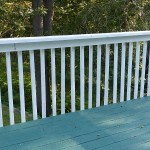by Winding Pathways | Oct 14, 2015 | (Sub)Urban Homesteading

Old railings on back deck limit view.
Early this spring we sat on our front porch staring at needed work and a home dilemma.
Our front porch and back deck were enclosed in traditional wood railings and balusters. About every other year the paint peeled. Scraping and repainting were tedious and time consuming chores that we didn’t want to do repeatedly. Also, each side of our home offers gorgeous views of oaks, maples, and a prairie plus the wildlife that visits our feeders and yard. From indoors, seeing through the heavy wood balusters and rails was hard.
Instead of scraping and repainting again, we paid a visit to Ogden and Adams, our neighborhood home store, and ordered an aluminum railing system for the front porch and a cable rail for the back deck. Then we ripped out the wood and installed the new porch railings ourselves. We’re not carpenters so we watched installation videos and read the instructions that came with the materials. It took time figuring, cutting and assembling, but we were able to successfully install the railings ourselves. And once in place we were delighted with their appearance and the amazing ability to see into the yard. These products are carried by most major lumberyards and home stores.

After installation. Easy to see through.
The white aluminum rails and balusters should eliminate all future need to scrape and paint, but even better is the increased visibility they offer. The old balusters were 1 ½ inches across, while the aluminum ones are but 3/4ths of an inch. That may not sound like much but the front porch has nearly 60 balusters, meaning that we now have about 40 more inches of clear unobstructed vision. Essentially the new ones offer only half the visual blockage of the old wood ones. This lets more light enter the house and more cool breeze to waft through on hot summer days. From the road the difference is indiscernible. The impact of the cable system on the back deck is even more dramatic. The tightly stretched stainless steel cables are nearly invisible and are remarkably easy to see through. When we peer at our bird feeder our eyes focus in the distance and the nearer cables become a mere shadow.
We’re delighted with our new railings. Safe, low maintenance, attractive, and easy to see through!
by Winding Pathways | Oct 5, 2014 | Nature, Trees/Shrubs
October is a wondrous month of great change in the backyard. Thousands of leaves that devoted warm months harvesting solar energy now become free and fun soil builders.
Fall’s shortened days cause backyard elm, maple, oak and other trees to hang it up for the season. Green chlorophyll disappears revealing reds, yellows and browns that were there all summer but were masked by verdant green. Soon puffs of breeze bring dry leaves swirling to the ground.
We can perceive October’s leaf fall two ways. It’s either a season of drudgery or harvest of a free, organic and bountiful resource.
Raking, bagging and stacking zillions of leaves on the curb for the city to cart away is drudgery that gives away a precious resource.
Better to view leaves as wondrous tree gifts. Those multitudes of mini solar collectors are rich in carbon destined to become topsoil. All humans need do is enjoy and appreciate them and perhaps corral leaves so they won’t blow into the neighbor’s yard.
Kids love leaves. Have them help rake them into a dry pile in the center of the yard. Then pretend you’re a ground hog and burrow under the nearly weightless mound. Just make sure the kids don’t play in leaves stacked in the street for pickup! A car could plow through them and cause a tragedy.
All leaves decompose. Look closely and notice that the leaves of maples, elms, ashes and locusts tend to be flat and make a mat on the ground that soon absorbs moisture. They rot fairly fast. In contrast oak and hickory leaves curl to allow air to circulate under them when on the ground. They stay dry and resist rotting but eventually turn into humus.
Leaves make excellent compost material but need nitrogen to speed decomposition. Alternate layers of leaves with manure in the bin this fall and pitchfork out wonderful compost when gardening season starts next spring.
An easier way to put the annual leaf harvest to good use is to mulch them. Simply pile layers of leaves around young trees, shrubs and even in the garden, then wet them down so they don’t blow. Most likely they won’t be rotted away next spring but will hold moisture in the soil and reduce weed growth most of next summer. A year from now they will have been miraculously transformed into humus.
Leaves are wondrous, fun and a handy, free resource. Enjoy them this fall and thank your trees for sharing their organic solar collectors.
by Winding Pathways | Aug 15, 2014 | Nature, Trees/Shrubs
We are lucky to have four species of oak trees on our property. Huge white oaks hug the north end with a few red oaks scattered between them. Two medium sized black oaks live close to the house and a young bur oak is just beginning to cast shade south of the house.
Millions of other homeowners are also fortunate to have oaks shading their property. They are one of the most widespread trees, and are beautiful, sturdy, valued by wildlife and long lived. A white oak could shade the ground and feed squirrels for up to 400 years. Some species, like red oaks, grow relatively quickly and tolerate moderate shade while most other oaks, like our bur, need full sun and grow slowly.
About 600 oak species are found naturally across the northern hemisphere. Approximately 90 species live in the United States. China boasts around 100 species, and Mexico is probably the world leader in oak diversity with at least 160 species. They have been widely planted in temperate regions including many places where they don’t occur naturally.
Oaks are members of the beech family with the genus name Quercus. It’s rather easy to distinguish an oak tree, but determining just what oak species a tree belongs to can be tricky. Many oaks hybridize with similar oak species and a tree may have characteristics of each parent. Sometimes the shape of an oak leaf near the top of a tree may be shaped differently from a counterpart lower down.
Non-showy oaks flower in mid spring about the time leaves appear. Male blooms are slim, drooping and green or tan in color. Each female flower is a solitary spike. People allergic to the wind borne pollen generally suffer in the spring.
Throughout history oak wood has been readily used by people. Even wine corks are made from the bark of Portuguese oaks. Oak was widely used in the construction of sailing ships. It’s said that the oak sides of the USS Constitution were so tough that British cannonballs bounced back. That’s where the nickname Old Ironsides came from! Oak is the traditional wood for liquor aging barrels but today it is most commonly used for hardwood flooring and furniture. Few woods produce more fireplace heat than oak.
Squirrels are just one of the wildlife species that love acorns. Among the host of other wild animals that relish acorns are deer, bears, woodchucks, wild turkeys and blue jays. However, oak leaves or acorns can be toxic to cows that eat too many. Tannin is the bitter element in oaks and acorns and long ago humans learned how to remove it to create delicious food. Each fall we look forward to harvesting acorns. Few foods are as delicious as maple syrup on warm acorn muffins.
Subscribe to Winding Pathways to learn how to process acorns into food.
For further Information
One of the most fascinating tree books ever written was published back in 1948. It is a two volume set by David Culross Perry. One volume covers trees of eastern North America while its counterpart describes western species. If you spot it for sale at a garage or used book sale snap it up.
Websites, apps and books abound that help identify and learn about trees. Our favorite websites are from the National Arbor Day Foundation at and the US Forest Service. Our favorite tree identification book is the Sibley Guide to Trees.


